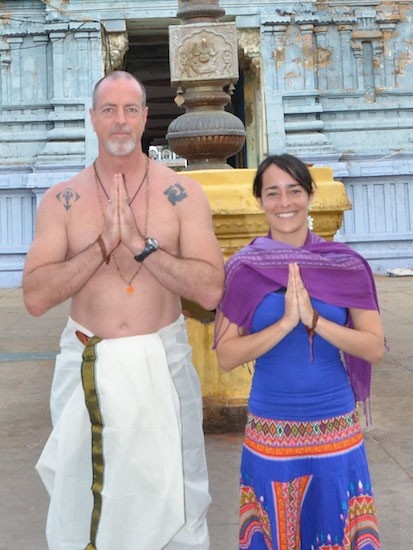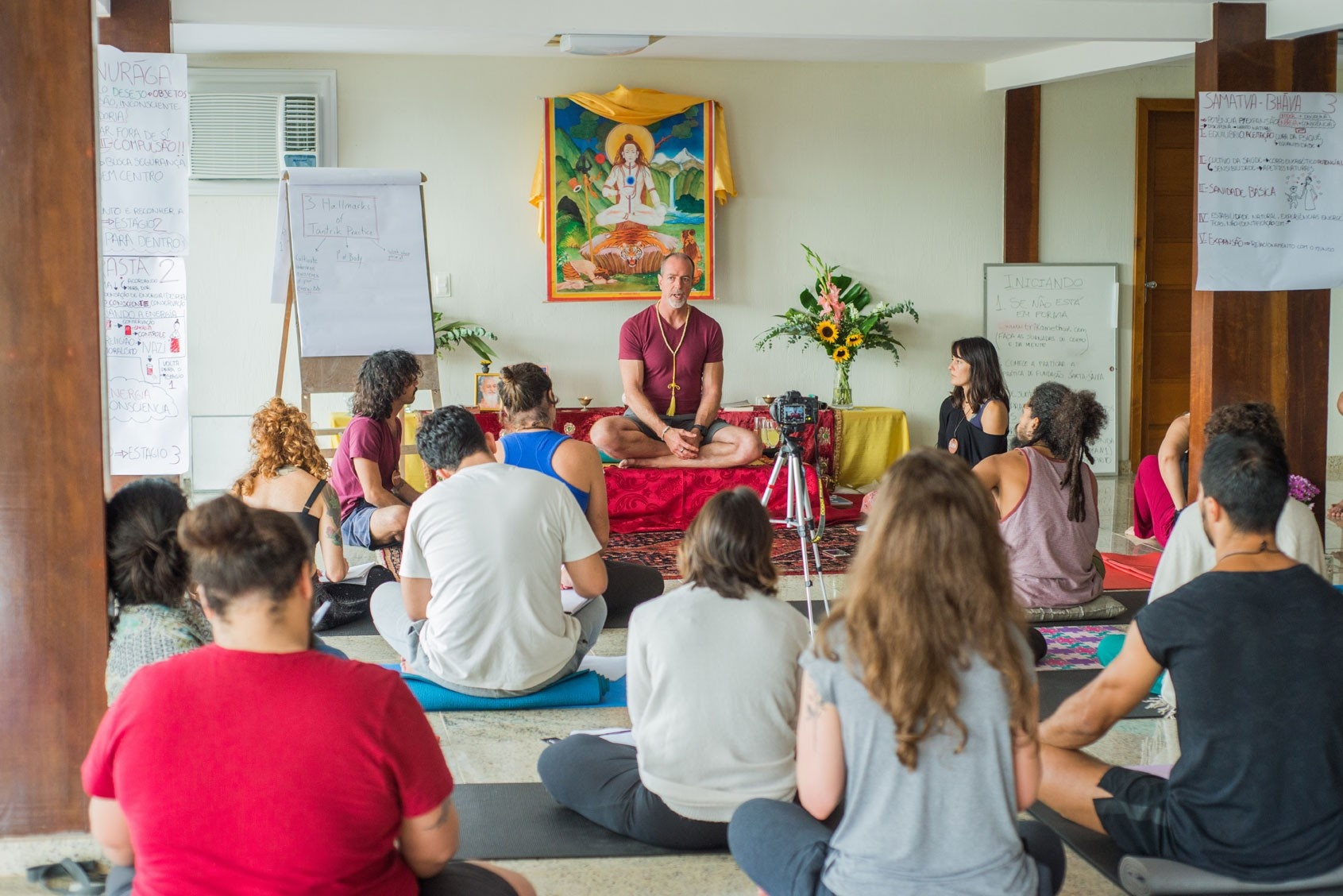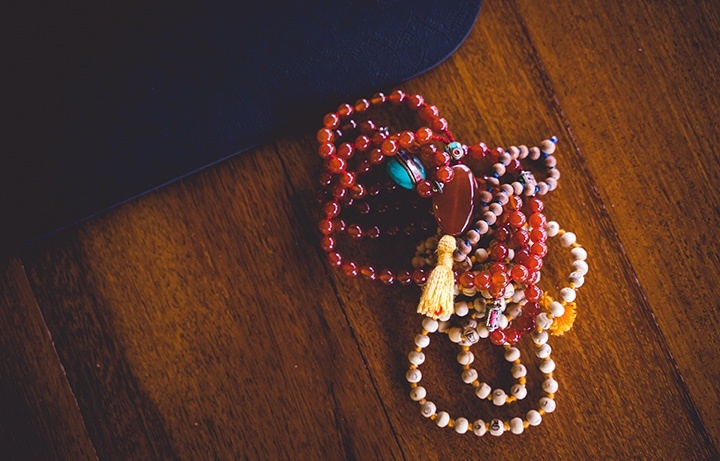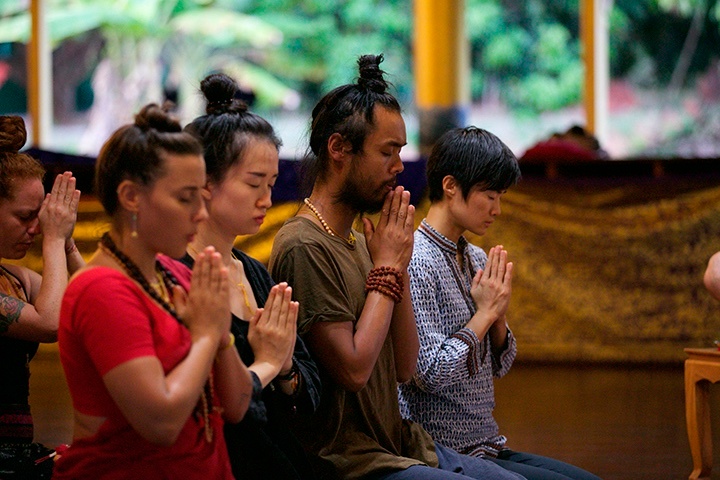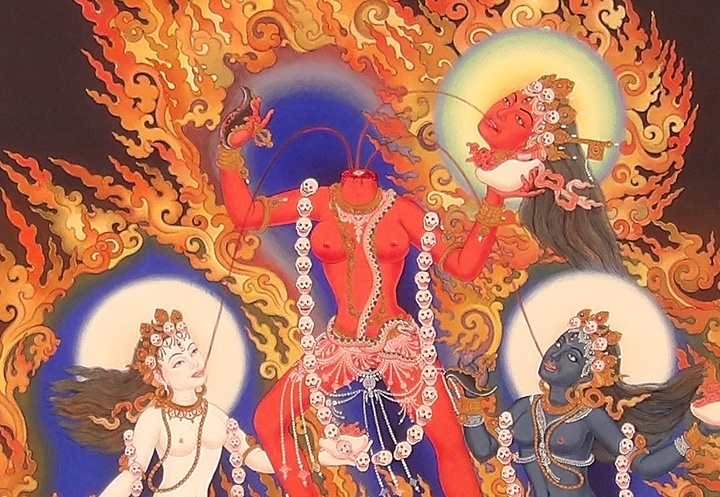Artist: Dinesh Shrestha
Story of Trika
Mahāsiddha Yoga

If you’ve made it to this website you’ve probably been asking yourself the same questions that have driven me my whole life:
“Why do I suffer?”
“Is there anything I can do to be free of this incessant suffering?”
“Is there any larger meaning to life?”
“What happens when we die?”
“Who am I?”
“Is there something more essential to me than my thoughts
and feelings, something that lives on after death?”
To find the answers to life’s most crucial questions I searched far and wide, spent tons of money in my teens, twenties and thirties traveling to meet masters in remote locations in the US, South America, Asia, India and Europe. In particular, I was looking for anyone who had a system of understanding (view) along with a system of directly discovering that understanding for myself – a system of practice (method). And I especially was interested in finding a system with a strong history of having produced the results of self-realization for many generations. I wanted something scientific in the sense that it is reproducible. Lot’s of people believe they have a very high potential for enlightenment, but I wasn’t so confident. I wanted to go a tried and true, proven way using a well-tested method to find the answers to the questions that burned inside of me.
As I read stories of the great masters of enlightenment I started to see that in the beginning they usually struggled mightily with the limitations of their mind and energy (negative karma) that caused them to suffer, usually needing to undergo decades of purification. I saw that the great masters I was reading about and finally meeting weren’t really super gifted spiritual aspirants as much as they were completely committed to their realization and to the system of meditation and yoga they were using to discover their true nature. And that it was by following a method laid out by their spiritual ancestors aided by their complete dedication to the teachings, practices and their teachers that they became irreversibly enlightened. Not only did they no longer suffer but they lived for the benefit of all beings! A wonderful result and a wonderful life, no doubt!

I became a student of many teachers until in the 80’s I settled down with one system, one lineage and one teacher of that system. I realized that although I had a fair bit of training in many spiritual systems by the time I was only 25, that I didn’t complete any of them. I needed to get deeply grounded in a system and to peel the layers of my “onion” to reveal my true nature.
I was trained in science in undergraduate school and went on to receive a clinical doctorate in health science after that, so I had a well-developed sense of discrimination and critical analysis, not to mention resourcefulness, self-authority and the acceptance of full responsibility for my life that comes with that authority. Let’s say that I wasn’t about to get snowed. I owe this rugged individualism not only to my training in science, meditation and martial arts but to the wild New York City years of my youth which gave me a degree in “street smarts”. All of this is to say that I was fairly good at examining a spiritual system and its teachers, and figuring out if they had a good stable state of realization. And if they did, I could accurately assess whether they could effectively transmit that state and their system of practice to me.
I finally got the grounding I sought in a tradition that my teacher merely called “yoga”. This system of “yoga” as it turns out was a very detailed and precise methodology for training the mind and body, followed by going beyond the thinking and awareness-mind into the deeper capacities that lie dormant within. This potential energy of unlimited consciousness exists in a “veiled” condition within all human beings. My masters from India called this energy-consciousness “kundalinī”.
Ten years after I began training in this system of “yoga” I graduated from training. I said I wanted to enter retreat practice as a hermit in the mountains and they said “No, you are to teach. It would be selfish not to share the knowledge of this path that you have received.” They said that my re-payment to my teachers and the lineage masters for the gift I had received was to help people learn to transform their experience of life from suffering to realization and liberation as they had helped me do for myself. So I changed course internally and started to embrace a life of teaching. I ended up making a few more trips to see my teachers in India before feeling finally that my study with them was complete. And sure enough, true to their style it was on these trips, only after they had graduated me and sent me away that they bestowed some of the real gems of our tradition such as the 12 Stage View Teachings. Always testing…
But I still felt slightly deficient in knowledge because my teachers emphasized a path of unbroken oral transmission and dedicated practice eschewing the use of text books. When I asked them what I was to teach they said “Teach your experience.” I said… “…Sure, great, but…what should I say when students ask me questions?” To this my teacher said, “If you want to teach like that, you’ll have to read books.” He meant traditional philosophy texts. I laughed aloud when he said this but immediately began a serious process of study. I read all the available books from the great traditions of spiritual practice – Kundalinī Hatha Yoga, Nondual Śaivism, Veda, Vajrayana, Daoism, Bön, etc. I even became a partner in a spiritual book shop in Varanasi, India because I was spending all day in the shop reading!
From my reading I gained a deeper appreciation for the system of teachings and practices I learned from what I came to call the OPT, or Oral-Practice Tradition. I saw that the OPT I learned was the pith or the core of what all the great practice traditions from India, Tibet and China have in common, and the reason why they continue to produce masters of great attainment or Mahāsiddhas in Sanskrit & Grub-thob Chen in Tibetan. I also saw that the learned proponents of each of these systems often fought with each other over which system is better which seemed to me to be a monumental waste of energy based on egoic pride, and I finally understood why my teachers relied on orally transmitted knowledge and direct experience with expert guidance over text and debate.
The OPT I trained in used entire systems of practice in these categories: Contemplations on Virtues, Dynamic and Passive Meditations, 5 Elements Practices, Systems of Kriyā Yoga, Classical Mind Training, Non-Conceptual Meditation, Advanced Meditations on Light and Space, Kundalinī Hatha Yoga (aimed at creating and controlling the energy of consciousness such as Mahākumbhaka [Sanskrit] ), Deity Yoga, Mantra, Transference of Consciousness, Consort Yoga, Dream and Sleep Yogas, etc. There are also entire systems of oral teachings or what we term “View Teachings” that explain every aspect of the practices and the path as a whole.
Before my teacher left the body in true yogi fashion,… sitting upright in lotus posture and remaining that way for days without a heartbeat or breath, gathering all the vital energies and consciousness into the central channel then taking them out through the top of the crown…he recommended that I finish my post-grad studies with the Tibetan yogis. He said he had travelled in Tibet on foot as a young man and had trained in a monastery there. He had a great appreciation for Tibetan systems of meditation and it was from his urging that I began to attend Dzogchen retreats led by lamas of Vajrayana and Bön. Many years later, through a book that another kind teacher gave me I came into contact with and began my study of what is called Dzogchen meditation.

Artist: Kalden Grg
I saw in the path of Dzogchen the same emphasis on the pith, on what is essential to human realization as well as what my first teacher thought was so remarkable about Dzogchen – the rainbow light body – the yogic ability to physically resolve one’s karma of individuality and physicality so completely as to resume the most essential “form” of pure wisdom-light before dying. My Indian master was the first non-Tibetan to write about the wisdom-light body phenomenon in English in his books, and his discussions of it over the years peaked my interest to say the least.
Both my Indian and Tibetan teachers gave me the mandate to teach the essence of the path. To not elaborate and carry forward overly religious and cultural trappings, but instead to cut away any superfluous aspects of the path, refine it to its most essential elements necessary for liberation from suffering and to translate the most important teachings from Sanskrit and Tibetan into English in order to make the path of the Mahāsiddhas more accessible.

A modern spiritual path needs to be streamlined, efficient, even scientific in a sense. People in general don’t have the luxury to take an 18-month solo retreat like I did back in the 1980’s. Nowadays we have to work 50% more hours or even more than that to provide the same type of lifestyle that people had in the 1950’s and 1960’s. Therefore, our spiritual systems need to be changed and upgraded, not the essential teachings and practices, but the way in which the teachings and practices are delivered.
Modern people are also very much inclined towards science and averse to old style religions. I’m also one of those people, and this is why I’m happy to strip away the unnecessary aspects of culture and religion surrounding the gems of liberation in the Mahāsiddha yoga path. The OPT is very scientific in the sense that it doesn’t demand blind faith. It has reproducible results generation after generation. My teacher said “I have two arms, two legs, and a head,…so do you. If you follow these exercises they’ll work for you too because we are both human.” That really struck a chord with me.
The Path of Trika Mahāsiddha Yoga (TMY) is the essentialized path of complete human realization coming from the Oral-Practice Tradition. It’s a“living cannon” of teachings and practices developed and transmitted by, in my humble opinion, the greatest masters of spiritual science the world has ever known – the Mahāsiddhas, who all resolved individual physical embodiment through the process of the wisdom-light body rather than dying. This is not just a mythological story buried in the sands of time but rather a living tradition with new female and male Mahāsiddhas attaining some form of the wisdom-light body every year or two in Tibet, Nepal, China, or India. Despite what religious scholars may say Mahāsiddhas have come from all of the nondual meditation and yoga traditions of the east without prejudice: Tibetan Bön and Vajrayana, Śaivist Yoga, and Orthodox Daoism.
Trika in Sanskrit means “the three” and refers to the 3 essential aspects or “bodies” existing as one reality in every human being. It also denotes the 3 gateways to realization in practice – our body, our energy, and our mind. The word “Yoga” as used in Trika Mahāsiddha Yoga denotes a path of spiritual cultivation and does not refer to physical yoga, though TMY does make use of various traditional forms of yoga and other body practices.
So, that’s our story. We’ve created this website as a way for people to complete Preliminary & Foundation training in traditional Mahāsiddha Yoga via their computer. And as a way for people to have access to an ongoing learning portal as we continue to post self-guided series, offer live trainings, monthly Q&A sessions, and more.
Sincerely,
Dharma Bodhi

May All Beings Benefit!!!
SARVA MANGALAM!!!
TMY SYSTEM OF PRACTICE
Trika Mahāsiddha Yoga is a clear and comprehensive system of practice and guiding theory with many interrelated branches all leading the practitioner to irreversible realization of their own True Nature.
Students can learn at their own pace, stay focused in one track of study or customize their path to follow their particular interests and aptitudes. Trika Mahāsiddha Yoga’s modernized delivery system makes the teachings of nondual dharma accessible without sacrificing the effectiveness, integrity and sacredness of the tradition.
What is the relationship between TMY and the Mahāsiddhas?
What is Tantra?
TMY System Overview
Independent Cycles of Teachings & Practices
The following cycles are core, stand-alone topics that will supplement your main focus of practice in the 5 Ways.
◉ TANTRIK ENNEAGRAM
◉ SIX REALMS & YOGAS OF THE SIX REALMS
◉ ĀTMAŚAKTI
◉ UNLEASHING THE FORCE OF THE RED BINDU
◉ RUSHEN
◉ YOGAS OF DREAM, SLEEP & DEATH
"Entering the Stream"
This is the traditional way of beginning Dharma practice. Entering the Stream gives a progressive method of learning and practice wherein each step builds upon the previous step, thus creating a solid foundation, overview and understanding of the teachings, practices and path. It is recommended that you first take the Peliminaries of TMY, followed by the Foundations of TMY. Though some students who are more ambitious and have a bit more time on their hands will engage with Preliminaries, Foundations and Kundalinī Hatha Yoga simultaneously, while they prepare to attend the next offering of the Entering the Stream In-Person Retreat, and that’s ok too.
The 5 Ways to Realization
Within Trika Mahāsiddha Yoga there are 5 complete and unique, yet interrelated paths of practice and teachings. Each of The 5 Ways to Realization are 5 approaches to practice and the path that are capable of taking you from rank beginner in the Dharma to the ultimate experience of your own True Nature – that of Buddhahood.
Choose Your Way:
Select your main Way of Realization. You may freely attend any of the other Ways’ trainings as well in order to support the practice of your main Way, or just out of interest.
Way of Meditation
Way of Mirror Consorts
Way of Fire
Way of Water
Way of Warrior
Each of the 5 Ways has two phases of practice.
PHASE 1
The Relative Practice Phase - "The Path of Transformation"
This phase is characterized by a step-by-step approach to the knowledge and practices that ensure the beginner and intermediate level practitioner’s unbroken and stable progress through the spiritual work of discovering, or revealing, the inherent perfection at the core of every human being’s experience.
PHASE 2
The Direct Realization Phase - "Vajra Path"
Training in the Direct Realization Path teaches us how to begin to live in the fruit of ultimate realization. As the name suggests the Direct Realization Path is not progressive, rather its sole focus is on discovering and stabilizing the unbreakable and inherent experience of one’s True Nature.
Independent Cycles of Teachings & Practices
Trika Mahāsiddha Yoga also offers Independent Cycles of Teachings as online courses and in-person retreats. These programs do not require any prerequisites. They present core teachings and practices as stand-alone topics and as supplemental to your main focus of practice in the 5 Ways.
Tantrik Enneagram
Six Realms & Yogas of the Six Realms
Ātmaśakti
Unleashing the Force of the Red Bindu
Rushen
Yogas of Dream, Sleep & Death
TMY Lineage Tree
Bringing together streams of Non-Dual Dharma Practice Lineages from Daoism, Tibetan Bön, Dzogchen and Trika Śaivism.

About Dharma Bodhi
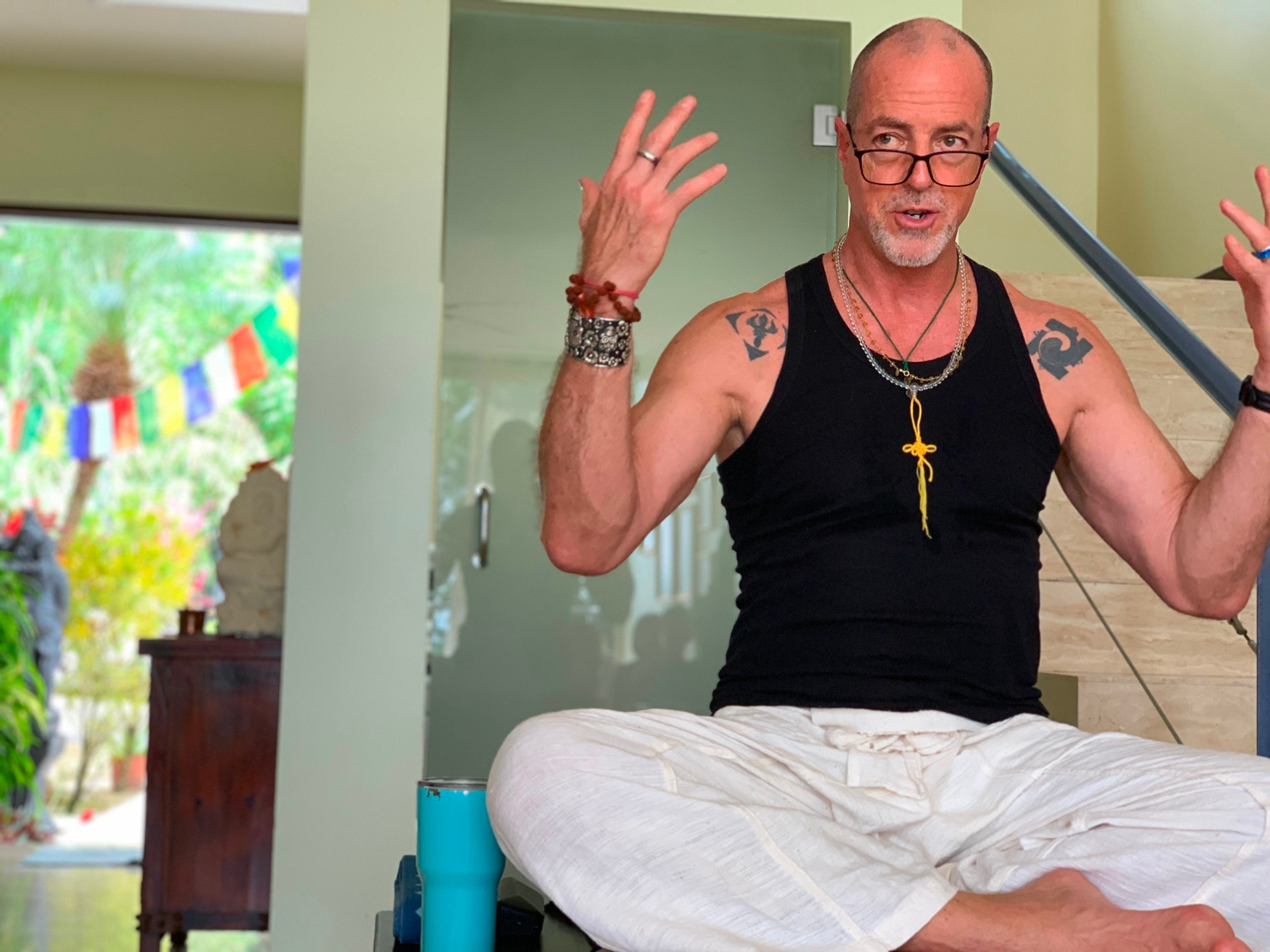
Dharma Bodhi (Kol Martens) was born in Chicago in the Water Tiger year of 1962, into a Catholic family. Dharma Bodhi didn’t know his father until he met him at the age of 42. His mother raised two children on her own which made both children fiercely independent. As a young boy he had so many questions about God and the Universe that his mother would regularly take him to see the family priest to get a much needed break from this intensely curious child.Luckily a Tsalagi (Cherokee) man who was dating his mother when Dharma was 5, took a shine to him and taught him how to pray.
At 7, he started practicing traditional Hatha Yoga and begin his spiritual journey home. It was clear from the rapidity with which he gained skill in the postures, breathing techniques, locks and basic meditations of yoga that he was most probably “remembering” attainments carried through from previous lives. His life also continued on as a “normal” child playing sports and fooling around with other kids in the neighborhood.
From ages 5–16, Dharma would often see and hear “ghosts” or spirits and they would sometimes touch him or move objects in his room. Later in his 20’s, he would learn how to use this early experience in his work as a “ghost buster”, exorcising malevolent ghosts and spirits trapped in people’s homes and bodies.
At 12, he began training in a traditional martial arts school that only accepted 8 students before the teacher “closed the door” to new students. This warrior training of body, breath, mind and spirit along with yoga was beginning to stimulate a very deep urge within him to go deeper into and master the secrets of the spiritual path. It was during one particularly charged training atmosphere on Saturday morning, in his 13th year, when he first experienced a state of samādhi or śunya. The class was practicing an intense manipura cakra kriyā when Dharma Bodhi’s consciousness was suddenly and intensely expanded beyond limits, and yet clear and laser focused. He was aware of his body and its movement, the room, the students practicing around him and at the same time he felt this awareness had no location and was neither created or able to be destroyed or altered.
This was the arising of his True Nature which he recognized as spacious, empty of permanence, and the Base of All, but he was unable to self-identify with this potential pratyabhijña (recognition of one’s True Nature as Essence alone) moment and remained in a dualistic relationship to “It”. This experience lasted for about 5 minutes but would deepen his resolve to do the work necessary to eventually exist at that level of consciousness permanently.
One day when he was 13 and was skipping class by hiding from his teachers in an aisle of the school library, strangely a book fell from the shelf above. It was a book on the Buddha’s “Tripitaka”. He poured over its teachings, transfixed there on the floor he finished the small book and felt that in comparison to the Christian Bible that he was finally reading something that made sense to him in a deeply spiritual way. Shortly afterwards he discovered the Dao De Jing and for the next 7 years this mysterious and pithy text would become the guide for his meditation and his life.
Wanting to understand more about the mind and its power he took a course in training the mind for success by the leading American institution at that time. His best friend’s father had introduced both he and his friend at age 13 to this 3-month course. He learned how to focus and harness the energy of mind and emotion in order to achieve goals, and this would serve him well in later years.
Naively seeking to reform the Catholic Church by bringing the enlightened teachings of Lao Tze and Buddha into the catechism, Dharma enrolled in Seton Hall Preparatory High School in South Orange, New Jersey to begin his preparation for becoming a Catholic priest. However, by a stroke of grace, within a few months his Jesuit and Franciscan mentors urged him to quit the church and instead go deeper into the Asian paths because they felt that the answers he was looking for were to be found there. Realizing he could never make it through training for the priesthood with such a deeply heterodox view, and that the church would never change, he dropped out of that school at the end of the term and announced to his family that he would no longer be involved in church and was taking the path of the yogi. This dinner time announcement was greeted by his family with blank stares and discomfort.
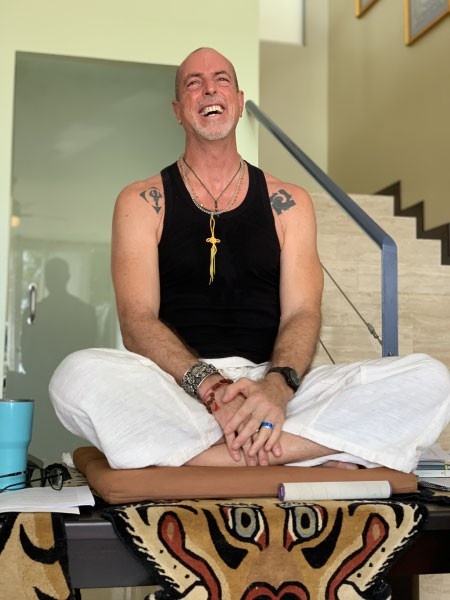
In the following year (1979) the same friend’s father who enrolled him and his friend in the mind training course for success, enrolled them in Silva Mind Control. This course opened dormant psychic capacities and showed Dharma the unlimited possibilities of the human mind such as distant diagnosis, touch healing of pain, telepathy, etc.
In the summer before entering university he chose to stay home to work and take a relaxed practice retreat rather than travel for the three months of summer to party before beginning university as most Americans kids did at that time. One day on his way to work as a short-order cook, while performing a gentle breathing and internal awareness exercise in the park near his house, he felt an explosion, a “pop” in his abdomen, and the strongest sensations as if a bottle of champagne had been opened in his belly and a stream of bubbles were rising swiftly up his core. The sensation rose inside the central channel of his body to about the throat level, and seemed to be a type of elation in itself. He felt a sense of wellbeing that he had never experienced before, that lasted for hours afterwards. This further fueled his drive to understand the nature of these experiences.
Daily practice of yoga continued from age 7 onwards, meditation which began sporadically at 12 settled into a daily groove by 15. He continued to practice yoga, meditation, mind training and martial arts during his freshman year of university. In the summer of 1981, between semesters, he chose to live alone in a small apartment and rise early each day for exercises, yoga, gong fu practice, contemplation of a verse from the Dao De Jing, and a long meditation by the peaceful and quiet tree lined banks of the Delaware river. This training also served another purpose as he was simultaneously training for entering the air-wing of the Marine Corps to help pay for university (he would fail his second flight test due to a problem with his vision and would leave the program). During this summer he would come directly home from his 16 hour a week job as an industrial cook for the university he attended and perform a second round of practices, then eat, read and go to sleep. He did this for 3 months. He took personal vows of celibacy and silence during these three months which led him to deeper realizations about the nature of life, death and his own path. This would be his first real and fairly austere practice retreat.
From 1980 -1984 Dharma spent every free moment in New York City’s Chinatown and Brooklyn New York training with great masters of gong fu and Daoism, or at the esoteric bookshops around Manhattan. This ran parallel to his intensive years studying biochemistry, genetics and psychology in university.
During this period he learned many systems of gong fu, qi gong and Daoist meditation. He would form a deep father-son relationship with the great spiritual master – Woo, Chai Meng - who lived in a tiny apartment in a project in a dangerous part of Brooklyn. Though master Woo was an unparalleled master of martial arts and passed the Emperor’s exam (trained to be a lineage holder in a Shaolin temple in Shanghai since he was 7 years old), it was his spiritual attainment, knowledge and virtuous conduct that attracted Dharma to him. After requesting each year for 10 years to be taught the deeper mysteries of his system, Master Woo finally acquiesced to Dharma’s pleas for instruction.
Dharma would travel from Australia to live in Master Woo’s home for weeks at a time to learn. At night he would sleep on his 4 foot long couch which was quite a yoga practice for a 6’3” person. Dharma noticed during these trips that Master Woo never actually slept but was up all night long, every night, performing various practices and on more than a few occasions demonstrated siddhis such as levitation, and being unaffected by fire.
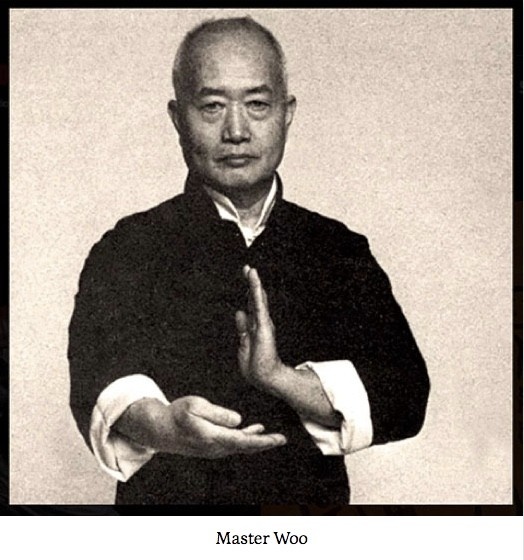
Master Woo taught him a type of Chinese mahākumbhaka/ gtummo performed while standing and moving. He also taught him his system of Transference of Consciousness (phowa in Tibetan, uccarana in sanskrit). Dharma and Master Woo would go to a basketball court across the street from Master Woo’s apartment after qi gong practice, early before sunrise, and sit cross legged (sometimes in the snow and ice), to perform the Transference practice, and as Master Woo would say….”liberate the ghosts”. His psychic eyesight showed him that there were legions of ghosts of deceased suffering people that accumulated there each day, and he saw it as his Dharmic duty to help them move on from the Hungry Ghost Realm. These lessons were some of the first teachings Dharma received in the technology of the 6 Realms. Master Woo was much more than a teacher to Dharma, he was the father he never had. He divulged many secret yogic practices and kept Dharma out of the organization run by Master Woo’s student body in order to “protect” him from the politics. Master Woo died at the ripe age of 112, fit and clear to the end.
In 1986 Dharma graduated from university with a clinical doctorate degree in chiropractic, post-graduate certificates in spinal bio-physics and physical therapy, and emigrated to Australia and passed the medical board there.
The years from 1986 – 1997 were filled with many wondrous encounters with masters of great attainment, both shamanic and yogic, too numerous to list. He continued deeper into his path and studied intensively with a Hawai’ian shaman or Kahuna named Abraham Kawai’I and with a Peruvian Ayahuascero named Don Augustin Rivas. Grandfather Thundercloud, a Cherokee medicine man famous for instantly healing cancers in his full moon ceremonies and being able to bring rain at any time and any place, whom Dharma had first met when he was about 10, began to train him in the Cherokee mysteries. These included oral teachings, pipe ceremony, sacred dances, etc. He was also blessed to learn the Sweat Lodge, the Sacred Pipe ceremony and oral teachings from Grandmother Kittyhawk (who also brought him to the home of Grandmother Twyla Nitch of the Seneca Nation), a friend of Thundercloud’s who was a direct lineage descendant of the famous Lame Deer clan (*see the excellent book – Lame Deer - Seeker of Visions. Dharma has Ojibwa and Greenland Innuit ancestors).

During this period he also went into the Carpathian mountains of the Ukraine immediately following the collapse of the Soviet Union to discover if there were any indigenous shamanic, yogic or martial arts being preserved there due to such limited contact with the outside world. Dharma and his Canadian-born Ukrainian guide would stay in Ukraine to train in the native dance called Hopak which was a type of martial dance that kept warriors fit and healthy for battle in times of peace. He would end up meeting practitioners of native Ukrainian martial arts in Kiev. Also he and his guide found their way to the homes of many amazingly talented shamans, witches and holy people only too happy to share their knowledge.
None was more amazing than Mikhail Lazarovych who was able to bring people back from the dead, a feat Dharma had heard about in his introductory training in prana vidya but had never seen or met anyone who had this power.
After staying with him for many days at his farm in the rural mountains Master Lazarovych asked Dharma and his guide to come back that year at Ukrainian New Year’s so that he could install him as his lineage successor because he wished to retire. Dharma politely told the master that it was not his fate to remain in those mountains as a shaman, though he expressed his eternal gratitude for all the he shared.
In late 1987, through very fortuitous circumstances Dharma met Mahatma Sarasvati in Narrabeen, Australia where he had been living and working. Dharma had been having a series of very strange out-of-body experiences during a 6 month retreat he was undertaking where he kept a regimen of 5 practice sessions per day with no outer contact other than the patients he saw each day in his clinic. Dharma had a burning desire to meet the master that was fated to take him beyond his mind, beyond the abilities he had developed thus far that amazed others but left him completely flat. He knew he needed a true guru, the person that can take one beyond their own mind and the myriad of spiritual experiences that obscure one’s True Nature. During this three month retreat he focused on purifying his attachments as much as possible and opening his heart to receive. He prayed fervently many times a day to meet his true teacher.
He quickly recognized that Mahatma would be his guide in beginning to learn Non-Dual Śaivite Tantrik Yoga and Meditation. After a few weeks of class in Mahatma’s home, Dharma left his chiropractic practice to his partner and began an apprenticeship with Mahatma. He would also work with him daily as a stone mason/builder.
Each day was like clockwork. 5:00am and 6:00pm yoga, kriyā yoga and meditation class, and lot’s of Q & A during the day working together. After a year of this he took initiation from Paramahamsa Satyananda Sarasvati and entered into 18 months of unbroken practice in seclusion supported by a group of friends and fellow practitioners.
His guru guided him in his meditation retreat through the subtleties of mind and energy. They communicated via hand-written letters taking months to arrive in Australia from India and via direct psychic contact during the dream state, meditation and normal waking hours. Needless to say he often wondered if he was losing his mind during this period. Thankfully he was able to confirm from other advanced yogin mentors of his in this system of practice, and from Paramahamsaji’s successor (Dharma’s Junior Guru Mahāraja) that Paramahamsaji did indeed work with people in these ways. This period was where he gained proficiency in meditation, kriyā yoga, dream and sleep yoga, mantra and astral projection because of the isolation and focus afforded in retreat. He emerged from retreat with a firm foundation in stage 5 and an even greater thirst to be trained in yet still deeper esoteric aspects of this path.
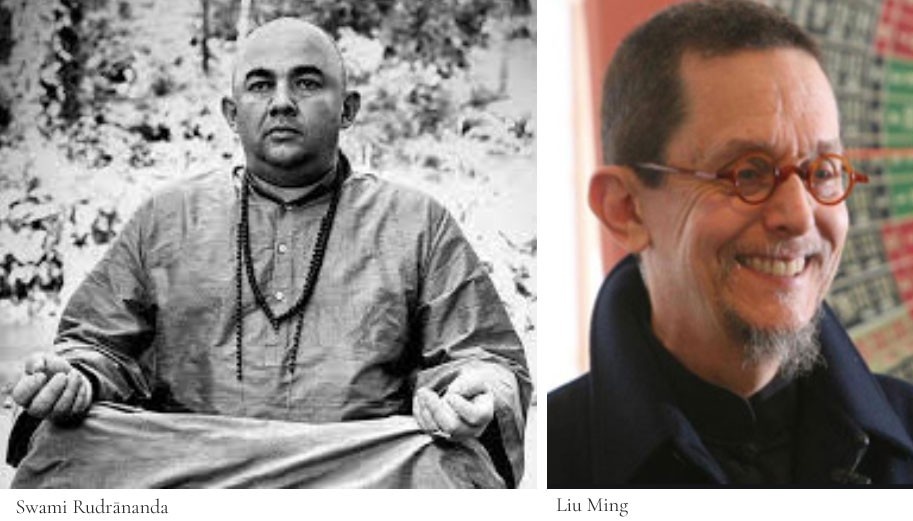
In 1990 Dharma had returned to his home place to care for his brother for the year. His brother would eventually die in a hospital in lower Manhattan. While living in Manhattan he learned of Swami Rudrānanda’s Kriyā Yoga system through a series of undeniable “contacts” with the now deceased “Rudi”, as his close students called him. These contacts, which occurred during the year in Manhattan, confirmed for Dharma that he had a genuine karmic connection to Rudi and his work. Dharma had dreams of Rudi and what initially seemed to be random meetings with some of his students who brought him to Rudi’s apartment then inhabited by an early student of Rudi. He would also discover that the book store near his apartment where he would hang out (where he bought his first book on Kashmir Śaivism) was Rudi’s old antique shop! The owner would allow Dharma to sit and meditate in an area of the store where Rudi himself used to sit and work with students one to one. He felt an increasing sense of connection and guidance from Rudi but as of yet did not know where this would all lead. This propelled him into the “Rudi Work”.
Eventually, through another “coincidence” he would meet his Rudi Work upaya guru in Lama Lar Short (who was Rudi’s Heart-Student up until Rudi’s death in 1973), and absorb Rudi’s system after 5 years of kind and generous one–one study and practice a few times a year in Lar’s home and temple in New Mexico. Swami Rudrānanda was a student of the great Siddha – Nityānanda Baba of Ganeshpuri, who was said to be Śiva incarnate. The Rudi Work was a perfect fit with the Śakta-Śaiva Tantrik Yoga Dharma was learning from his two Indian gurus and he seamlessly integrated it into his daily practice and eventually his teaching. Lar would also share many other powerful practices and teachings with Dharma.
Lar guided Dharma through the Tibetan version of Transference of Consciousness at the time of death during a weeklong solo practice retreat in Lar’s temple. And taught him the basic principles of Dzogchen view and meditation that Lar had received as a student of Dilgo Khyentse Rinpoche as well in-depth one to one teachings on the Six Realms.
In 1995 Dharma read of the American Daoist named Liu, Ming and he desired to meet him one day. Many years later in 1999 he was able to meet Liu Ming in person and thus began a 6-year period of part-time study and friendship wherein he was able to complete the circle and finish the Daoist studies he began in his youth in New York City’s Chinatown. In 2004 & 2005 he completed a two-year meditation program run by Liu, Ming using his excellent translation of the Dao De Jing. Concurrently he completed Liu Ming’s first ever two-year Daoist Pole-Star (Zi Wei) Astrology Certification course and was able to sit in on Liu, Ming’s private client readings as an apprentice because he and his wife lived next door to him during this period of time. Dharma also completed training in the Zhou Yi (Book of Changes) as translated by Liu, Ming and received transmission of many other Liu family text and pith instructions on alchemical practices, Dream Yoga, Tomb Affairs and Zuo Wang (non-conceptual sitting). Liu, Ming and Dharma co-taught a summer retreat on the 12 Stage View Teachings at Pema Ösel Ling Dzogchen Retreat Center in 2005. Liu Ming has since passed away but kindly donated his set of 12 Stage View paintings to Dharma before his passing.Dharma was blessed to be close to such an amazing practitioner/scholar.
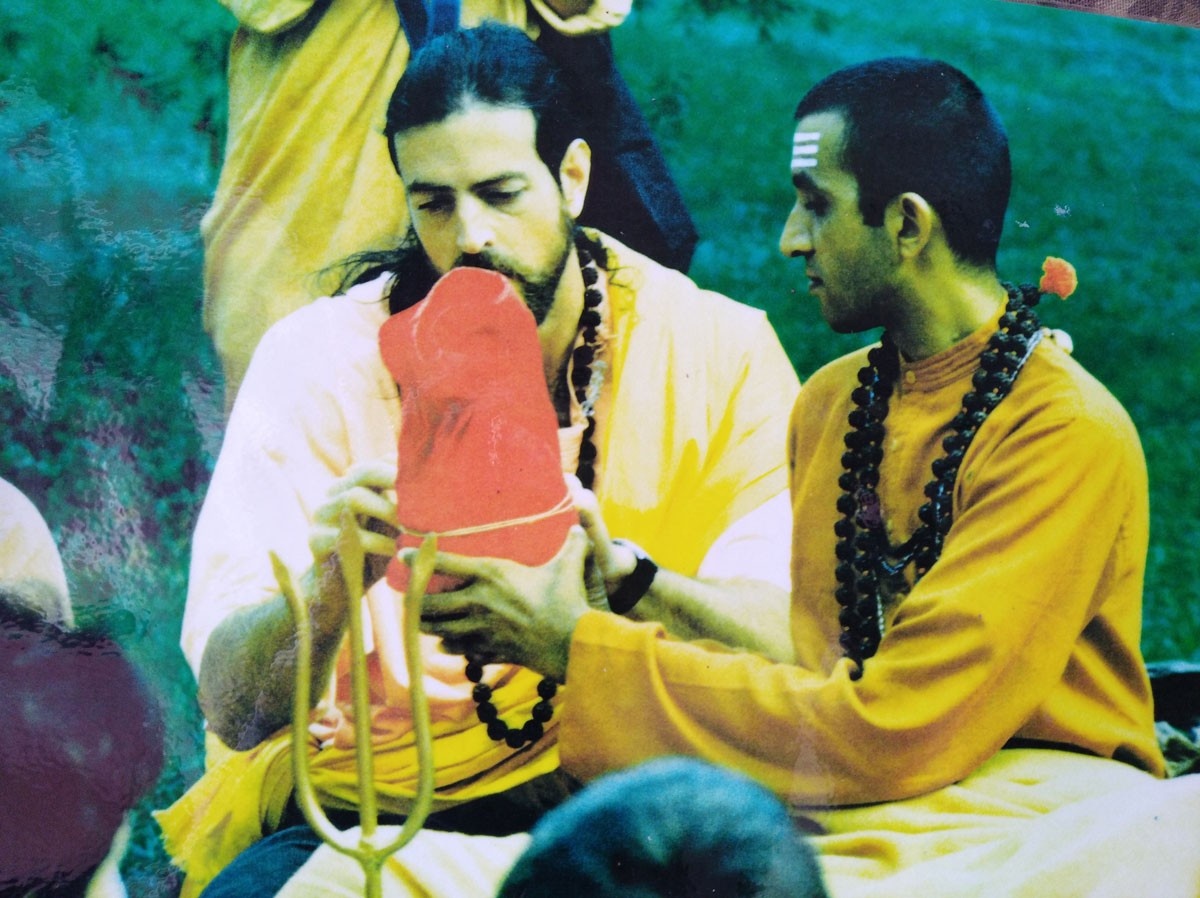
In 1997 Dharma completed his formal studies with his Indian gurus (though the transmission of the 12 Stage View Teachings would come three years later during the Mahākumbha Mela) in nondual Śaivite Yoga and meditation, and received the purnadiksabhisekha (empowerment) from Paramahamsa Satyānanda’s chosen successor, Paramahamsa Niranjanananda of the Sivānanda Lineage. This combination of his years of diligent practice, the “quickening” environment of his gurus’ presence and a 10-day ritual empowerment facilitated by three special yoginis and his guru - thrust Dharma into a very deep state. He would remain in this condition for six months. Upon returning to Australia his wife compassionately took over all of his duties in the clinic until he was re-integrated and able to return to work.
The system he received from his gurus was an oral practice tradition that did not make direct use of the study of any sacred texts. The system emphasized practices and oral teachings. It was mostly a synthesis of the Krama, Kaula, Trika and Śrī Vidyā sects teachings and practices laid out in the form of a 12 Stage path of realization with practices appropriate to each stage. True to the syncretic nature of Indian spirituality the system also seems to have been cross-pollinated over many centuries with teachings and practices from Indian Tantrik Buddhism (and most probably Tibetan Tantrik Buddhism after that), Dzogchen and Daojia.
These imported teachings and practices were incorporated over the ages creating a seamless system which Dharma would re-name Trika Mahāsiddha Yoga. This Nondual Dharma System emphasizes the human masters who attained the Rainbow Light Body (instead of dying a normal death of exhaustion). Deity yoga takes a supportive and lesser role in the tradition of the Mahāsiddhas which focuses on meditation, inner alchemy and yogic cultivation.
It is common for a traditionally trained ācārya or teacher to learn many branches of knowledge that support the central axis of the meditation, inner alchemy and yoga curriculum. To this end Dharma also completed training in Indian astrology (jyotish), palmistry (hastasamudrika), sacred architecture & geomancy (vastu) with master Hart de Fouw and a number of his senior disciples. He studied Ayurvedic medicine with Dr. Vasant Lad and still studies with Dr. Ravindranath of Poonthottam Ayurvedaśram. Dharma trained to become proficient in water offering rituals (puja), and fire ceremonies (yajña & homa) under the compassionate and kind tutelage of Śrī Rami Śivan of Blacktown, New South Wales, Australia, and is a member in good standing of the Australian Council of Hindu Clergy.
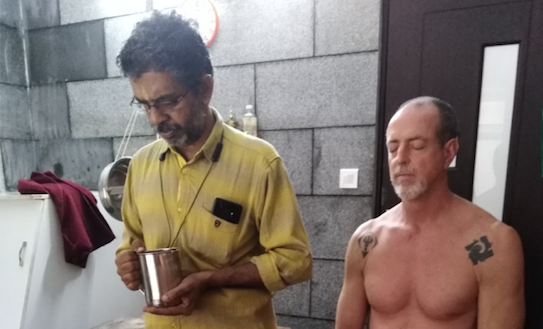
From 1994 to 2001 Dharma made numerous trips to study and train in India. He often travelled to desolate caves, mountains, cremation grounds and abandoned temples inhabited by the master yogis and yoginis in deep retreat in places such as Tryambakeswara, West Bengal, Varanasi, Rishikesh, Ellora, Kolkata, Aurangabad, Alandi, Ganeshpuri, etc.
After receiving the purnadiksabhisekha (empowerment) Dharma was told by his gurus to move back to the United States to find students with capacity for advanced teachings and practices who were unable to find an authentic lineage transmission based tradition. After looking around the southwest of America for a few years he settled down from 1999 to 2007 in Oakland, California. Dharma and a handful of dedicated students co-founded Yoga Mandala Yoga studio wherein he taught classes and maintained a small Ayurveda medicine practice. In 2007 Dharma moved his family to Kailasa Akhara, a retreat property in the northern mountains of Thailand where he lived, practiced and taught until moving to Costa Rica with his family in 2017.
His journey into the world of Tibetan Yoga and Meditation began at his Indian teacher’s prompting. He read an amazing meditation manual by a Tibetan Bönpo Lama named H.H. Tashi Shardza Gyaltsen Rinpoche who, in 1935, performed the Great Transference or the Rainbow Light Body manifestation instead of dying. This text clarified many of the questions Dharma had regarding the various spontaneous manifestations of spheres and mandalas of light that he was beginning to see during his time both in and out of meditation. This book further inspired him to attend Dzogchen meditation retreats held by Ayang Rinpoche in Bodh Gaya, India and with Penor Rinpoche in Canada. After this he took many meditation and View Teaching programs with other lamas including Namkhai Norbu Rinpoche whose non-sectarian style of teaching appealed to Dharma.
This initiated an intensive personal study of the Mahāsiddhas of the traditions of Śaivism, Bön, Vajrayana, and Daoism. Through this study and many conversations with living Mahāsiddhas, Dharma became convinced that an approach to spiritual work that did not dilute the teachings or power of lineage transmission but emphasized a non-sectarian and secularized presentation of the teachings and practices would be of great benefit to the West and possibly be the only way that a westerner could actually receive and benefit from the Path.
In 2005 Dharma took refuge in India with the great Dzogchenpa (practitioner of Dzogchen meditation) and Bön Lama, H.H. Lungtok Tenpai’I Nyima, the 33rd Menri Trizin. From day one Rinpoche bestowed countless spiritual blessings upon Dharma.

He gave Dharma his own copy of the Ku Sum Rang Shar along with the notes he wrote in it (the A-Z text of Dzogchen written by Shardza Rinpoche). He also kindly bestowed upon him the lung or “reading” transmission of the Kalung Gyatso (a preliminary practice text written by Shardza Rinpoche) and the Twenty-One Nails (a core text of what are known as Dzogchen “pointing out” instructions). His Holiness also gave him one to one instruction in the 15 sessions of A-Krid Dzogchen and His Holiness’ own statue of Drenpa Namkha (one of the major Mahāsiddhas of the Bön tradition) from his personal altar.
Dharma constructed a full-size Dzogchen temple on his retreat property in northern Thailand that was beautifully painted by the lama who painted His Holiness’ temple in India. Into this was placed a vases containing precious substances his master had empowered with 365 daily ceremonies. There were only 108 of these vase’ made and distributed by His Holiness to authenticate centers of Bön teaching and learning around the world.
Through his teacher’s compassionate, wise and generous guidance Dharma has studied with different lamas who represent two great lines of Dzogchen meditation, the A-Khrid & the Zhang Zhung Nyan Gyüd. He was fortunate to have received transmission of three systems of Bönpo Yoga from a lineage holder.
His master explained to him the deep karmic link that he has to H.H. Tashi Shardza Gyaltsen Rinpoche. Shardza Rinpoche has said that “all you need to become enlightened is meditation and yoga”. This struck a chord in Dharma’s heart and now he dedicates his life to preserving the meditation, yoga and philosophy of the Mahāsiddha Traditions. He and a close spiritual friend, Geshe Sonam Rinpoche translated into English and published a preliminary practice prayer manual composed by Shardza Rinpoche called “Precious Chariot of the Three Trainings”. Dharma is currently undergoing practice retreats seeking to stabilize the advanced meditations of Dzogchen, and he may someday teach Dzogchen Meditation at his center in Maine as his great master directed.
Dharma’s Dzogchen master’s kindness and generosity knew no bounds. His pith instructions transformed Dharma’s understanding, practice, and life. Dharma is dedicated to repaying his master’s loving kindness by perfecting the practices and preserving them.
When Dharma organized his system of presenting these profound teachings he used the “Way of the Mahāsiddhas” as both the core and the “face” of the system. The Mahāsiddhas are women and men trained in one or more of the 4 non-dual systems of meditation and body practices (yogas) with origins in Central Asia: non-dual Tantra of Kashmir, Tibetan Bon/Dzogchen, Tibetan Buddhism/Dzogchen, and Chinese Zheng Yi Daoism. These great masters transcended the religious and cultural limitations, caste-ism, racism and sexism within the politics of their birth religions and societies to create the “Human Path of Enlightenment”. In their path, religion and belief are not necessary.
The Mahāsiddhas passed on their teachings and they survive inside of the 4 “religious” traditions just named. All Mahāsiddhas demonstrate their complete union with the greater universe through displaying the Rainbow Body of Light rather than getting old and dying from decay and depletion as is the usual way for people. They left behind a technology that enables anyone with a pure heart to realize their highest potential as a human being.
In 2013 Dharma began to scale down his active teaching schedule to focus on a translation project and to become more involved in the raising and education of his two children. In 2014 he began a project to catalogue everything he had learned in this OPT or Oral-Practice Tradition, over his lifetime with great masters and to make the essence of this learning available via books and the internet.

Dharma Bodhi currently lives with his wife, Sahaja Dākinī, and their two children in Maine, USA. They are currently in the process of building a rural retreat center in Maine where they plan to live, practice and teach while their children finish school. They also plan to establish a small retreat center in Northern Italy in the near future.
